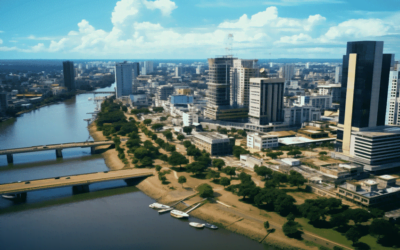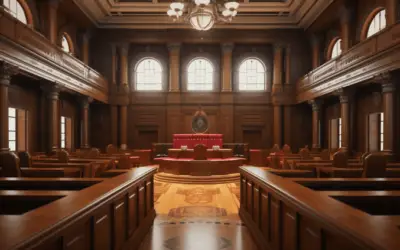Hey there, fellow drone enthusiasts! If you’re here reading about Argentina drone laws, I get it—navigating through the sea of regulations can feel like trying to decipher a secret code.
Whether you’re a seasoned pro or just dipping your toes into the world of aerial adventures, understanding the legal aspects is crucial. So, let’s get ready to unravel the mysteries and explore the skies of Argentina safely and legally.
You know, I was once in your shoes, trying to make sense of Argentina’s drone regulations. Through in-depth research and plenty of legwork, I’ve got the answers you’re seeking.
I’ve combed through the official documents, spoken to experts, and experienced the process firsthand. I can’t wait to share my insights and the wisdom I’ve gathered along the way to help you navigate the Argentine drone landscape with confidence.
So, if you’re eager to understand Argentina drone laws better and unlock the secrets of safe drone operation in this beautiful country, keep reading.
In the following pages, I’ll provide you with practical advice, real-life examples, and all the vital information you need. By the time you finish reading, you’ll be well-prepared to take to the skies and explore Argentina’s stunning landscapes with your drone legally and responsibly. Let’s dive in!
- Regulatory Authority for Drone Operators
- Drone Registration and Categorization
- Argentina No-Fly Zones for Drone Pilots
- Argentina Altitude Limits for Drone Pilots
- Argentina Visual Line of Sight (VLOS)
- Remote Identification
- Insurance Requirements for Drone Operators
- Commercial Use and Permits for Drone Pilots
- Argentina Regional Variations in Drone Laws
- Final Thoughts on Argentina Drone Laws
- Frequently Asked Questions on Drone Laws in Argentina
Regulatory Authority for Drone Operators

Alright, let’s dive into the heart of the matter—the regulatory authority that keeps the drone world in check within Argentina. Understanding who’s holding the reins is crucial when it comes to flying those sleek drones in the sky.
Overview of the National Civil Aviation Administration (ANAC)
If you’re a drone aficionado planning to soar the Argentinean skies, you’ll soon become acquainted with the National Civil Aviation Administration, fondly known as ANAC.
They are the watchdogs, the guardians of the airspace, making sure everything that goes up comes down safely and in one piece. Imagine them as the traffic controllers of the aerial highway, ensuring the smooth flow of drone traffic.
ANAC’s role in enforcing and updating drone laws
Now, let’s talk shop. ANAC isn’t just a fancy title; they’ve got a job to do, and they take it seriously.
They’re the authority responsible for crafting the drone rules and regulations and setting the ground rules for what you can and can’t do up there. Picture it like the rules of the road, but in the air.
They also keep their finger on the pulse, constantly updating these laws to adapt to the ever-evolving drone landscape. Just like software updates on your phone, the laws are upgraded to ensure optimal performance and safety in the drone domain.
Also Read: Antigua and Barbudan Drone Laws 2024
Drone Registration and Categorization

Let’s get our paperwork in order, shall we? Understanding the registration and categorization of drones in Argentina is like getting your driver’s license before hitting the road. It’s all about safety and accountability.
Explanation of the weight-based categorization for drones
Drones weighing less than 500 grams
Think of these drones as the lightweight champions of the sky. These little guys weigh less than your average sandwich. Now, while they might not be the big players, they still have rules to follow. Even lightweights need to abide by certain guidelines to keep our airspace safe.
Drones weighing between 500 grams and 25 kilograms
Alright, now we’re moving up in the weight class. Drones in this category are the middleweights, and they come with their own set of rules. It’s like driving a family sedan compared to a bicycle—there are more responsibilities but also more freedom to explore the skies.
Drones weighing over 25 kilograms
These are the heavyweight champs of the drone world. Imagine them as the commercial airliners of the drone universe. These hefty and powerful drones have an entirely different level of regulations. Piloting one of these requires serious know-how and adherence to the law.
The registration process for drones over 500 grams
Required information for registration
Much like you need to provide your personal information and vehicle details to register a car, drones above 500 grams have their own registration requirements. You’ll need to provide essential information about your drone, including its make, model, serial number, and your own details. Think of it as giving your drone its very own ID card.
Registration fees, if applicable
Now, here’s where it gets interesting. Just like obtaining a driver’s license, drone registration might come with a fee, depending on your location and the drone’s weight class. It’s like the toll you pay to use a particular road; in this case, it’s the sky.
These fees help fund the management and regulation of the airspace. So, remember, safety in the skies is never free, but it’s worth it for all of us up there.
Argentina No-Fly Zones for Drone Pilots

Alright, let’s talk about no-fly zones. Every pilot, whether in a cockpit or behind a drone controller, needs to know where they can and can’t go. It’s like driving a car but with a few extra hurdles – and a little less pavement.
Identifying restricted areas where drone flights are prohibited
1. Proximity to airports and aviation infrastructure
Picture this: you’re on the road, and you spot a “Dead End” sign. Well, for drone pilots, airports and their surroundings are like giant “No Entry” zones.
Flying your drone anywhere near these areas is a no-go, not even a little peep into their airspace. The last thing you’d want is a drone bumping into a jumbo jet!
2. Military installations and other sensitive locations
If you’ve ever watched a spy movie, you know they have these top-secret places that you can’t just waltz into. Well, the drone world has its own secret spots.
Military installations, government buildings, and sensitive locations are off-limits for your drone. They’re like the classified sections of a library—only authorized personnel get access.
Consequences of violating no-fly zones
Okay, here’s the deal: breaking the rules can have consequences. If you venture into a no-fly zone, it’s like running a red light in a busy city. The authorities take these violations seriously. You might face fines, legal trouble, or even risk your drone being confiscated. So, take a page from the driver’s handbook: obey the signs, and you’ll enjoy a smooth ride in the drone world.
Argentina Altitude Limits for Drone Pilots

Let’s talk about how high you can go in the Argentinean skies. Understanding altitude limits is like knowing the speed limits on different roads. It’s all about safety and sharing the skies with others.
Explanation of the maximum allowable altitude for drone flights in Argentina (usually 120 meters)
In Argentina, the rulebook sets a maximum altitude of around 120 meters (that’s about 400 feet) for drones. Think of it as a ‘ceiling’ you can’t breach.
This limit is designed to keep drones safely below the airspace where commercial and passenger planes are cruising. It’s kind of like traffic lanes on a highway – everyone has their own space to keep things flowing smoothly.
The importance of adhering to altitude limits for safety and airspace integration
Now, why is this ceiling so crucial? Well, safety is paramount. Imagine you’re driving, and someone zooms by you way over the speed limit – it’s a recipe for disaster. In the drone world, exceeding altitude limits is a safety hazard.
It not only endangers your drone but also risks collisions with other aircraft. By sticking to the 120-meter rule, we ensure that the skies remain a safe and harmonious space for all aerial adventurers.
Argentina Visual Line of Sight (VLOS)

Alright, let’s talk about keeping our eyes on the prize – or in this case, our drones. The concept of Visual Line of Sight, or VLOS, is all about ensuring that you don’t lose track of your flying buddy up in the sky.
Requirement for drone operators to maintain a visual line of sight with their drones during flights
In Argentina, it’s a clear-cut rule: drone operators must maintain a visual line of sight with their drones during flights.
This means keeping your drone in your line of vision at all times, much like you’d keep your eyes on the road while driving. It’s about being responsible and aware of what your drone is up to, ensuring you can take immediate action if needed.
The purpose of VLOS regulations and how they promote safe drone operations
So, why does VLOS matter? Think of it as the essence of safe and controlled drone flight. By keeping your drone within sight, you can react swiftly to any potential issues or obstacles. It’s like how a pilot keeps their eyes on the instruments and the sky to ensure a safe flight.
VLOS regulations are all about preventing accidents, ensuring safety, and making sure everyone – from drone operators to those on the ground – can enjoy the skies without worry.
Remote Identification

Alright, we’re about to delve into some tech wizardry here. Remote identification might sound complex, but it’s like the license plate on your car – a way for us to identify and track drones in the sky.
Discussion of the necessity of equipping drones with remote identification systems
Why do drones need remote identification? It’s all about accountability and responsibility. Imagine driving a car without a license plate – you can’t track who’s who.
With drones, remote identification ensures that everyone knows who’s operating that little aircraft up there. It’s a safeguard to keep everyone honest and the skies secure.
How remote identification systems work and their role in tracking and monitoring drone flights
So, how does it work? Think of remote identification as your drone’s digital ID card. It broadcasts essential information, like the drone’s serial number, operator details, and location, to authorities on the ground. It’s like a GPS tracker, but for drones.
This information helps authorities monitor flights, respond to incidents, and ensure that all operations are on board. Remote identification is all about keeping our virtual skies orderly and secure.
Insurance Requirements for Drone Operators

Time to talk about the safety net—insurance. Just like you wouldn’t drive a car without coverage, operating a drone without insurance can be a risky business. Let’s explore what it’s all about.
Overview of liability insurance for drone operators
Liability insurance for drone operators is a lot like car insurance. It’s there to protect you and others in case something goes wrong during your drone flights.
If your drone causes damage or an accident, liability insurance helps cover the costs. It’s a safety net that ensures you’re not left with a hefty bill in case things take an unexpected turn.
The importance of insurance in covering potential accidents or damage caused by drones
You might be thinking, “Why do I need insurance for my drone?” Well, accidents can happen to the best of us, and drones are no exception. Whether it’s a malfunction, a strong gust of wind, or a sudden technical glitch, drones can sometimes end up where they shouldn’t.
Liability insurance is your safety cushion, ensuring that if your drone, heaven forbid, causes harm or damage, you won’t be left in a tough spot. It’s about being a responsible pilot and making sure that you’re prepared for the unexpected in the world of drones.
Commercial Use and Permits for Drone Pilots

Time to talk business, quite literally. When it comes to using your drone for commercial purposes, there are some extra hoops to jump through. Let’s explore what it takes to go pro in the drone world.
special permits or authorizations required for commercial drone operations
Thinking of turning your drone into a money-making machine? That’s where the special permits or authorizations come into play. Just like starting a food truck or opening a shop, commercial drone operations need an extra layer of approval.
These permits are like the licenses that a food vendor needs to operate on a street corner—they ensure that you’re playing by the rules while using your drone for professional gigs.
The process for obtaining permits for activities like aerial photography, surveying, and other commercial drone applications
So, how does it work? Well, it’s a bit like opening a new restaurant. You need to apply, show your plans, and get the green light from the authorities.
For activities like aerial photography, surveying, or any other commercial drone applications, you’ll need to prove that you have the skills, the equipment, and the safety measures in place.
Think of it as setting up a new business – it’s exciting, but it comes with a checklist to ensure everything’s in order before you start earning with your drone.
Argentina Regional Variations in Drone Laws

Here’s a twist you need to be aware of in the drone adventure – regional differences in the regulations. Just like different states in a country might have their own road rules, drone regulations can vary depending on where you are in Argentina. Let’s unpack this geographical twist.
drone regulations may vary by region within Argentina
Yep, it’s true, drone regulations aren’t one-size-fits-all across Argentina. Different regions might have specific rules or guidelines tailored to their unique needs.
It’s a bit like how a coastal town might have different laws about beach access compared to an inland city. Understanding this regional diversity is crucial to being a responsible drone pilot, ensuring you’re always on the right side of the law.
research and comply with specific local regulations where applicable
So, what do you do if you’re planning to fly your drone in a new area? It’s a bit like going on a road trip – you research the local rules.
Find out what’s required in the region you’re heading to, and make sure to comply with any specific local regulations.
Think of it as following the local traditions when you’re visiting a new place. Whether you’re capturing breathtaking landscapes or conducting business, doing your homework on the local drone laws ensures you’re in harmony with the regional nuances.
Final Thoughts on Argentina Drone Laws

We’ve covered a lot of ground in our journey through Argentina’s drone laws. It’s time to wrap up and reflect on what we’ve learned about keeping those drones soaring responsibly in the skies of Argentina.
In the end, it all comes down to being an informed and responsible drone pilot. Argentina’s drone laws are designed to ensure the safety of everyone in the airspace, and understanding these regulations is vital.
It’s a bit like getting a driver’s license—you need to know the rules of the road. So, whether you’re capturing stunning aerial photos, surveying landscapes, or just enjoying the thrill of flying, make sure you’re aware of the laws that govern your adventures.
To sum it up, responsible drone operation isn’t just a legal requirement; it’s a commitment to safety and respect for the skies and those who share them.
It’s like sailing a boat—you navigate the waters with care, avoiding hazards, and respecting the environment. Whether you’re a hobbyist or a professional, let’s fly our drones with respect for the law, awareness of our surroundings, and a passion for safe and unforgettable aerial experiences in Argentina. Happy flying!
Frequently Asked Questions on Drone Laws in Argentina
1. Do I need to register my drone in Argentina, and how do I go about it?
Yes, registration is mandatory in Argentina for drones weighing over 500 grams. You’ll need to provide essential information about your drone, including its make, model, and your own details. It’s like giving your drone its very own ID card. The process ensures accountability and safety for all drone operators.
2. What are the maximum altitude limits for drone flights in Argentina?
The maximum allowable altitude for drone flights in Argentina is usually 120 meters (about 400 feet). Think of it as a ‘ceiling’ you can’t breach. This limit is designed to ensure the safety of both drones and manned aircraft in the airspace, much like traffic lanes on a highway.
3. Are there specific no-fly zones in Argentina, and what happens if I violate them?
Yes, there are no-fly zones, particularly around airports, aviation infrastructure, and military installations. Violating these zones can lead to serious consequences, including fines, legal trouble, or the confiscation of your drone. It’s like running a red light in a busy city – authorities take these violations seriously.
4. What’s the deal with insurance for drones in Argentina, and why do I need it?
Liability insurance for drone operators is essential, just like car insurance. It’s there to protect you and others in case of accidents or damage caused by your drone. If your drone happens to cause harm, damage, or an accident, liability insurance helps cover the costs. It’s a safety net to ensure you’re not left with a hefty bill
5. Can I use my drone for commercial purposes in Argentina, and what permits do I need?
Yes, you can use your drone for commercial purposes, but it requires special permits or authorizations. Think of it like opening a new business. You need to apply, demonstrate your skills, and get approval. Whether you’re into aerial photography, surveying, or other commercial drone applications, research and compliance with specific local regulations are key. It’s like ensuring your new restaurant or shop meets all the necessary requirements before you start earning with your drone.













